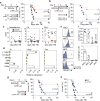Suppression of luteinizing hormone enhances HSC recovery after hematopoietic injury
- PMID: 29309056
- PMCID: PMC5803436
- DOI: 10.1038/nm.4470
Suppression of luteinizing hormone enhances HSC recovery after hematopoietic injury
Erratum in
-
Corrigendum: Suppression of luteinizing hormone enhances HSC recovery after hematopoietic injury.Nat Med. 2018 Apr 10;24(4):525. doi: 10.1038/nm0418-525b. Nat Med. 2018. PMID: 29634695
Abstract
There is a substantial unmet clinical need for new strategies to protect the hematopoietic stem cell (HSC) pool and regenerate hematopoiesis after radiation injury from either cancer therapy or accidental exposure. Increasing evidence suggests that sex hormones, beyond their role in promoting sexual dimorphism, regulate HSC self-renewal, differentiation, and proliferation. We and others have previously reported that sex-steroid ablation promotes bone marrow (BM) lymphopoiesis and HSC recovery in aged and immunodepleted mice. Here we found that a luteinizing hormone (LH)-releasing hormone antagonist (LHRH-Ant), currently in wide clinical use for sex-steroid inhibition, promoted hematopoietic recovery and mouse survival when administered 24 h after an otherwise-lethal dose of total-body irradiation (L-TBI). Unexpectedly, this protective effect was independent of sex steroids and instead relied on suppression of LH levels. Human and mouse long-term self-renewing HSCs (LT-HSCs) expressed high levels of the LH/choriogonadotropin receptor (LHCGR) and expanded ex vivo when stimulated with LH. In contrast, the suppression of LH after L-TBI inhibited entry of HSCs into the cell cycle, thus promoting HSC quiescence and protecting the cells from exhaustion. These findings reveal a role of LH in regulating HSC function and offer a new therapeutic approach for hematopoietic regeneration after hematopoietic injury.
Figures




Similar articles
-
Tie2(+) bone marrow endothelial cells regulate hematopoietic stem cell regeneration following radiation injury.Stem Cells. 2013 Feb;31(2):327-37. doi: 10.1002/stem.1275. Stem Cells. 2013. PMID: 23132593 Free PMC article.
-
Luteinizing hormone signaling restricts hematopoietic stem cell expansion during puberty.EMBO J. 2018 Sep 3;37(17):e98984. doi: 10.15252/embj.201898984. Epub 2018 Jul 23. EMBO J. 2018. PMID: 30037826 Free PMC article.
-
Total body irradiation causes residual bone marrow injury by induction of persistent oxidative stress in murine hematopoietic stem cells.Free Radic Biol Med. 2010 Jan 15;48(2):348-56. doi: 10.1016/j.freeradbiomed.2009.11.005. Epub 2009 Dec 2. Free Radic Biol Med. 2010. PMID: 19925862 Free PMC article.
-
Hematopoietic stem cell injury induced by ionizing radiation.Antioxid Redox Signal. 2014 Mar 20;20(9):1447-62. doi: 10.1089/ars.2013.5635. Epub 2014 Feb 10. Antioxid Redox Signal. 2014. PMID: 24124731 Free PMC article. Review.
-
The pro-Inflammatory cytokines effects on mobilization, self-renewal and differentiation of hematopoietic stem cells.Hum Immunol. 2020 May;81(5):206-217. doi: 10.1016/j.humimm.2020.01.004. Epub 2020 Mar 2. Hum Immunol. 2020. PMID: 32139091 Review.
Cited by
-
Sex differences in normal and malignant hematopoiesis.Blood Sci. 2022 Oct;4(4):185-191. doi: 10.1097/BS9.0000000000000133. Epub 2022 Aug 16. Blood Sci. 2022. PMID: 36311819 Free PMC article. Review.
-
Indole-3-carboxaldehyde ameliorates ionizing radiation-induced hematopoietic injury by enhancing hematopoietic stem and progenitor cell quiescence.Mol Cell Biochem. 2024 Feb;479(2):313-323. doi: 10.1007/s11010-023-04732-0. Epub 2023 Apr 17. Mol Cell Biochem. 2024. PMID: 37067732
-
New option for improving hematological recovery: suppression of luteinizing hormone.Haematologica. 2021 Apr 1;106(4):929-931. doi: 10.3324/haematol.2020.274969. Haematologica. 2021. PMID: 33297666 Free PMC article.
-
Reply to Jiménez-Alonso et al., Schooling and Zhao, and Mortazavi: Further discussion on the immunological model of carcinogenesis.Proc Natl Acad Sci U S A. 2018 May 8;115(19):E4319-E4321. doi: 10.1073/pnas.1802809115. Epub 2018 Apr 18. Proc Natl Acad Sci U S A. 2018. PMID: 29669926 Free PMC article. No abstract available.
-
A DNA tetrahedron-based nanosuit for efficient delivery of amifostine and multi-organ radioprotection.Bioact Mater. 2024 May 21;39:191-205. doi: 10.1016/j.bioactmat.2024.05.017. eCollection 2024 Sep. Bioact Mater. 2024. PMID: 38808157 Free PMC article.
References
-
- Dainiak N. Hematologic consequences of exposure to ionizing radiation. Experimental hematology. 2002;30:513–528. - PubMed
-
- Anno GH, Young RW, Bloom RM, Mercier JR. Dose response relationships for acute ionizing-radiation lethality. Health Phys. 2003;84:565–575. - PubMed
-
- Sanchez-Aguilera A, et al. Estrogen signaling selectively induces apoptosis of hematopoietic progenitors and myeloid neoplasms without harming steady-state hematopoiesis. Cell stem cell. 2014;15:791–804. - PubMed
Publication types
MeSH terms
Substances
Grants and funding
LinkOut - more resources
Full Text Sources
Other Literature Sources
Medical

